Are Pre-Internships the Way Forward?
March 19, 2024
Pre-Internships to Solve our Healthcare Crisis
The onset of the COVID-19 pandemic in March 2020 exposed and exacerbated pre-existing vulnerabilities within global healthcare systems. Hospitals and healthcare facilities worldwide faced an unprecedented surge in patient numbers, stretching their capacities to the brink. The high transmissibility and unpredictability of the virus, alongside significant morbidity and mortality rates, compounded these challenges, forcing healthcare institutions to grapple with workforce shortages while ensuring the delivery of quality care.
In response to the critical workforce shortages, Western Health in Victoria, Australia, introduced an innovative solution—the Clinical Assistant (CA) program. This initiative recruited final-year medical students on a voluntary basis to assist with administrative and low-risk clinical tasks within hospitals. Aimed at supplementing the strained healthcare workforce, the program offered a practical solution that also addressed disruptions to medical education due to the pandemic. Participants were compensated, worked flexible hours, and performed tasks aligned with their scope of practice under direct supervision, ensuring a balance between contributing to healthcare delivery and continuing their education. Could this be a more concrete solution to rising pressures for paid placements, whilst directly assisting our straining healthcare system here in Australia?
The Clinical Assistant’s Role
Clinical Assistants (CAs) in the program undertake a variety of roles tailored to the specific needs of different departments, reflecting the versatile approach to enhancing healthcare delivery during the COVID-19 pandemic and beyond. In departments with a direct focus on COVID-19, such as the Emergency Department and Respiratory Assessment Clinic, CAs are involved in initial screening assessments for COVID-19, including conducting PCR test swabs. Their responsibilities are critical in the early identification and management of potential COVID-19 cases, helping to mitigate the spread of the virus within healthcare facilities.
In the Dialysis Unit, CAs play a vital role in ensuring patient safety through infection control measures. They assist patients with hand hygiene and proper mask usage and are responsible for completing the COVID-19 community screening questionnaire. Additionally, they perform simple clinical tasks such as assessing patients’ weight and blood pressure, which are essential for monitoring the health of patients undergoing dialysis treatment.
The Western Public Health Unit leverages CAs for contact tracing efforts, a fundamental aspect of controlling the spread of COVID-19. CAs also provide crucial advice to high-risk businesses, aged and residential facilities, and educational institutions on best practices for COVID-19 management, reflecting their role in community health and preventive measures.
For pregnant patients affected by COVID-19, CAs in the Maternal Fetal Medicine COVID-19 Outreach program are responsible for contacting and triaging these patients. They facilitate coordination between the medical team, midwives, and home hospital services to manage the care of these patients remotely, ensuring that they receive comprehensive support while minimising the risk of virus transmission.
Beyond the COVID-19-specific roles, CAs also contribute to non-COVID-19-related tasks across various departments. In the Emergency Department, they are involved in the initial work-up of patients, which includes performing cannulations, conducting electrocardiograms, and assisting with other investigations. This hands-on experience is invaluable for their medical training and helps streamline patient care processes.
In General Surgery, CAs handle clerical and administrative tasks such as scribing ward round notes, creating draft discharge summaries, and booking patient review appointments. They also perform procedural tasks like cannulation, showcasing their ability to support both the clinical and administrative aspects of healthcare delivery. In Urology, their responsibilities include communicating with patients and external providers regarding pre-operative pathology and imaging, ensuring that all necessary pre-surgical assessments are completed efficiently.
Furthermore, CAs serve as EMR (Electronic Medical Records) Super Users, providing short-term support to staff during transitions to new digital systems for ordering fluids and other tasks. This role is pivotal in ensuring that technological transitions do not disrupt patient care and that staff are supported throughout the process.
Overall, the roles performed by Clinical Assistants are multifaceted, spanning administrative, clinical, and supportive functions across various departments. They play a crucial role in enhancing patient care, supporting healthcare workers, and ensuring the smooth operation of healthcare facilities during a challenging period.
What are the Direct Benefits?
The CA program demonstrates innovative workforce solutions, and a creative approach to mitigating workforce shortages during healthcare crises. Engaging medical students offers an immediate solution while providing them with invaluable experience. However, ensuring this approach does not detract from their educational needs is crucial. It also shows that the potential educational impact of such programs on medical education is significant. While they offer practical experience, there is a need to balance this with formal education to ensure students receive a comprehensive medical education.
The program’s success in keeping tasks within the students’ scope of practice, under strict supervision, minimises risks and enhances patient safety. This aspect is vital for maintaining quality care and offers a model for how similar programs can be structured. The program also allows for fair compensation and working conditions, reflecting an ethical approach to engaging students in the healthcare workforce. The implications of these aspects on students’ studies and well-being are important considerations for the sustainability of such programs.
The adaptability of this model to other contexts and its sustainability need thorough evaluation. While it presents a solution during crises, its long-term implications for healthcare delivery and medical education warrant careful consideration. In addition, the scarcity of literature on the topic highlights the need for more research to understand the impact of these initiatives. Such studies are crucial for informing future policies and practices in healthcare workforce management and medical education.
Are the Risks Worth the Rewards?
The integration of Clinical Assistants (CAs) into the healthcare workforce during a time of unprecedented challenge presents a complex balance of risks and rewards. On the one hand, the CA program offers tangible benefits by addressing acute workforce shortages, providing essential support to overburdened healthcare professionals, and enhancing patient care during the COVID-19 pandemic. It also presents a unique learning opportunity for final-year medical students, allowing them to gain hands-on experience in a real-world setting, which is invaluable for their future careers in medicine. The program’s flexibility and alignment with medical students’ educational competencies ensure that their involvement is both beneficial to the healthcare system and relevant to their learning objectives.
However, the deployment of CAs comes with inherent risks that must be carefully managed. The primary concern is ensuring that CAs work strictly within their scope of practice to maintain patient safety and care quality. There is also the challenge of balancing their educational needs with the demands of their roles in the healthcare system. Over-reliance on medical students could potentially detract from their formal education, potentially impacting the depth and breadth of their medical training. Furthermore, the psychological impact of working in high-stress environments, especially during a global health crisis, cannot be overlooked when looking holistically at the demands on medical students. It is essential to provide adequate support and resources to mitigate the risks of burnout and ensure the well-being of these student volunteers.
A Way Forward
The Clinical Assistant program in Victoria offers a compelling blueprint for leveraging the potential of medical students to address healthcare workforce challenges, not just in crisis situations but as a sustainable part of the healthcare ecosystem. Its success provides a persuasive case for other states to consider similar initiatives, potentially revolutionising how medical education and healthcare delivery intersect in Australia. This model not only enhances immediate patient care but also prepares medical students for their future roles in a very practical way. If adapted nationwide, it could significantly mitigate workforce shortages, improve healthcare outcomes, and enrich the medical education process. By fostering a closer integration of educational and clinical environments, Australia can pioneer a healthcare system that is resilient, adaptive, and future-ready.
Goodall, R. et al. (2024) Medical students: A potentially sustainable solution for our workforce crisis and future reforms in health care, The Medical Journal of Australia. Available at: https://www.mja.com.au/journal/2024/220/4/medical-students-potentially-sustainable-solution-our-workforce-crisis-and












